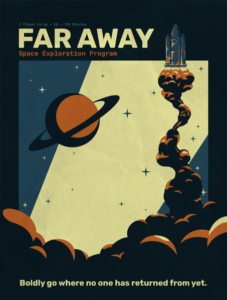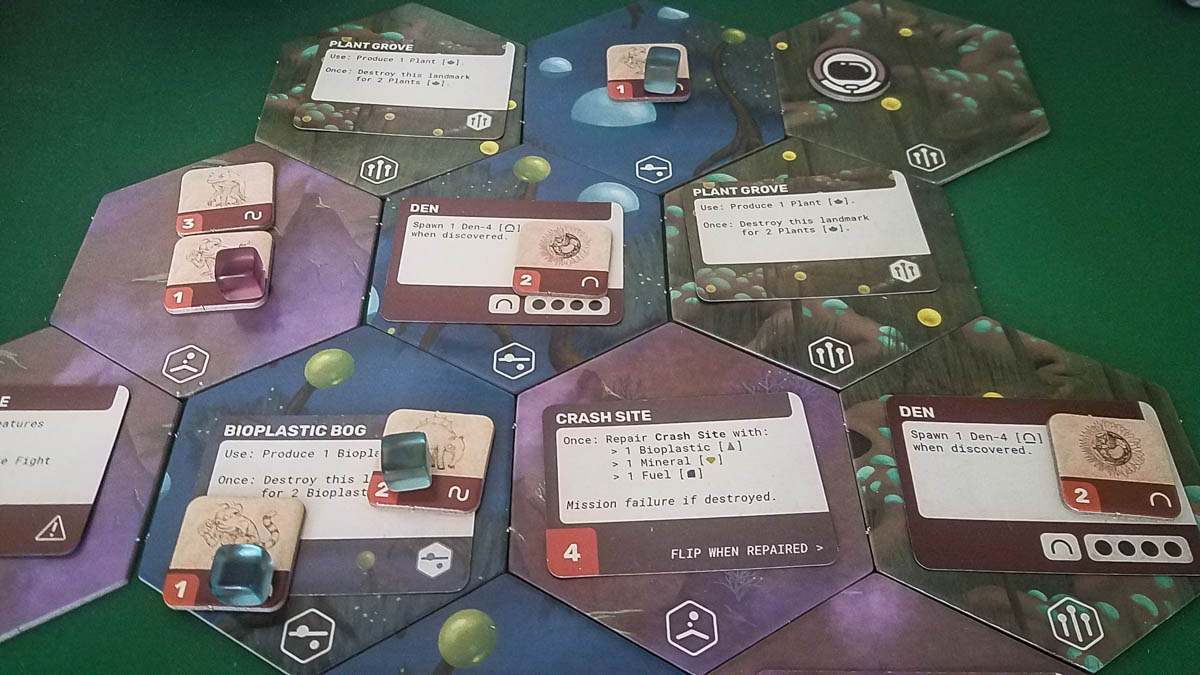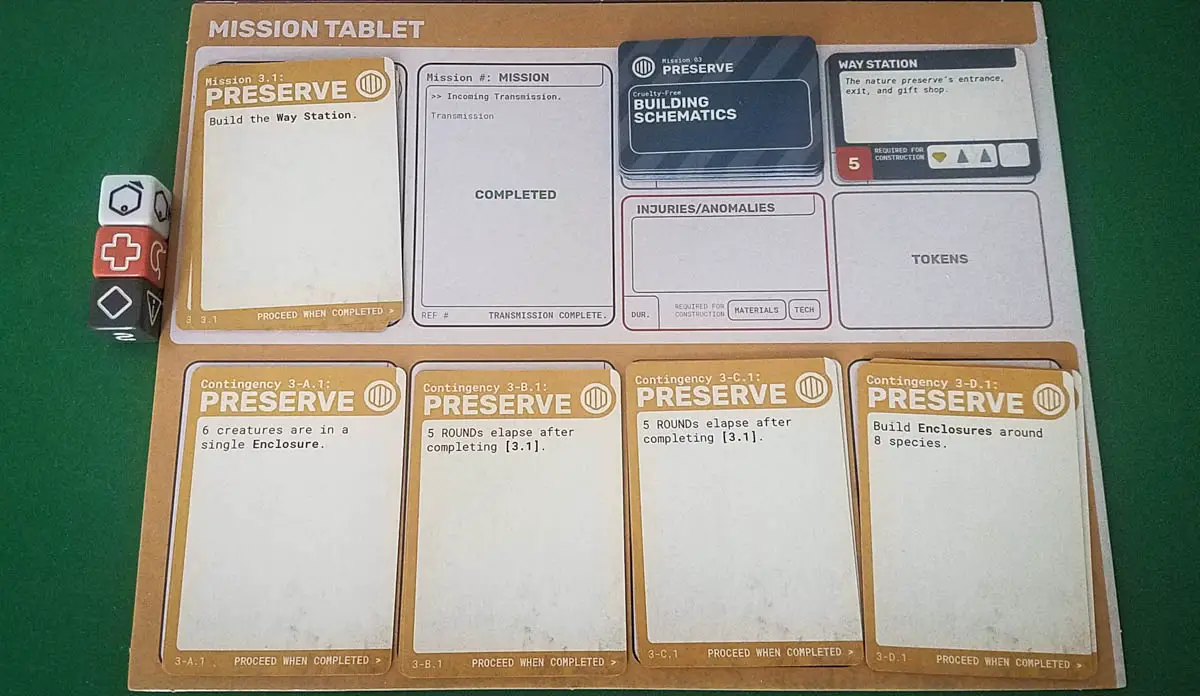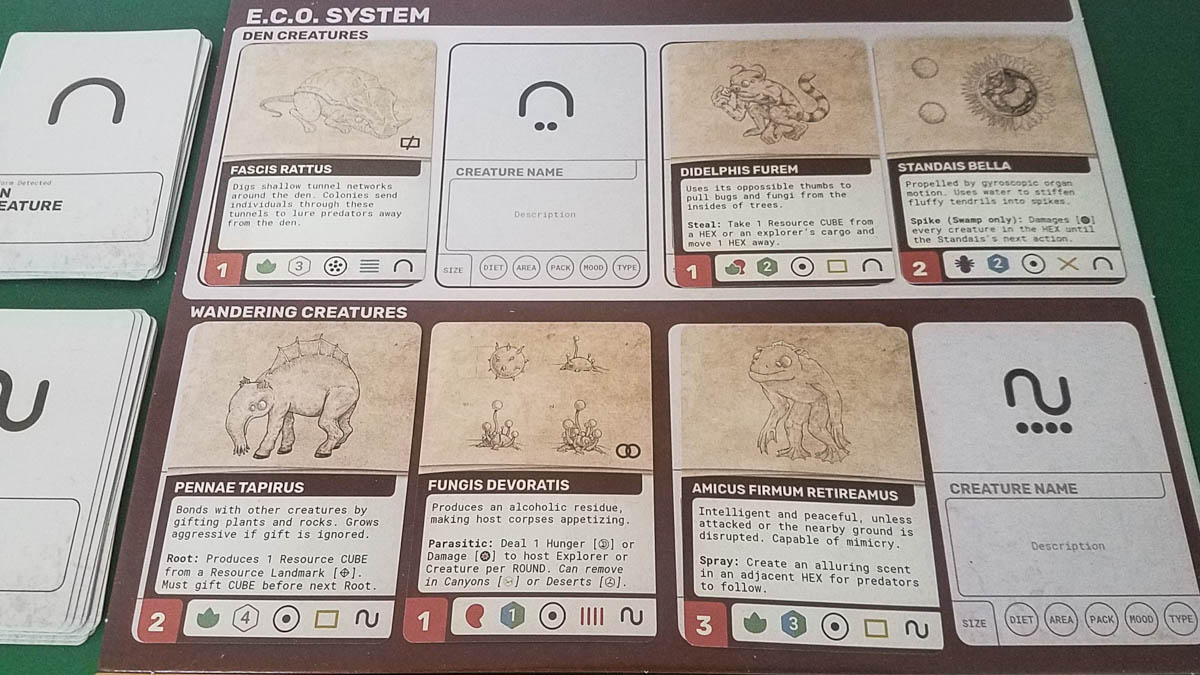Far Away Review
Year: 2020 | Players: 2 | Minutes: 90+ | Ages: 13+
This Far Away review was made after playing through five missions. We were sent a copy of this game by the publisher in exchange for an honest review.
What is Far Away?
Far Away is a two-player, limited communication, space exploration game in which you go on missions for a shady corporation to discover and map out new planets on a small budget. The game was designed by Alexander Jerabek and is published by Cherry Picked Games.
Rules Overview
Far Away has eight standalone missions (plus a tutorial mission) that can be played in any order. Each mission has a main objective and some side objectives, and you’ll be revealing new Mission cards each time you complete an objective.
In most missions you’ll be trying to build special buildings, repair your ship, and get off the planet you’re on. The problem is that each planet has a bunch of strange creatures that can slow you down in different ways and you have a limited amount of resources to work with. You and your partner play as explorers who have to complete those objectives, which is made even tougher because you can’t communicate unless you’re in the same location because your company couldn’t afford radios.
Each round you take turns taking actions until you’ve both taken three actions. You’ll explore the planet so you can find resources, which can then be used to build buildings and move around quicker, among other things. You’ll also sometimes have to fight creatures that are in your way, which is done by simply lowering their health by one per action until they’re out of health (and then a meat cube is put on the board). You can also build gear and find artifacts that will give you some unique abilities. After you’ve taken all of your actions, you’ll activate your drones if you have any and then the creatures will activate.
The creatures come in two types: Den creatures and Wandering creatures. Den creatures like to stay close to their dens, while Wandering creatures will move around more freely. Most of the creatures have special abilities and all of them have attributes that make them unique, such as their preferred terrain, pack size, and diet.
Each creature can move one hex and take one other action each round. The actions they can take depends on their attributes and special actions, but it is up to you to role-play them a bit and make their decisions for them. There’s a table in the rulebook to help you figure out which actions to take based on their behavior, but in the end it’s up to you to decide what to do with them. The creatures usually interact with each other and the environment, but they’ll also fight the explorers if it makes sense for them to do so. When a creature attempts to fight you, you’ll roll a die and see what happens. You can get Injury cards, which penalize you in different ways, but you can also get lucky and domesticate a creature, which allows you to control it during its turn.
After all of the creatures have activated, two new creatures show up, both explorers get a Hunger token, and both will also get a Loneliness token if they aren’t together. If either explorer ever gets their fifth Hunger or Loneliness token, you’ll fail the mission. You can remove all of your Loneliness tokens by being in the same hex as your partner and you can remove Hunger tokens by eating plants (or meat once you’ve built one of the special buildings).
Your goal is to complete the objectives before starving, becoming too lonely, getting two injuries, or allowing creatures to destroy your ship. Sometimes you’ll have to complete the objectives in a certain number of rounds. After each successful mission you’ll get some Mission Bonuses (sometimes permanent benefits) based on how well you did and you’ll also get some money to buy temporary benefits.
For more info on how the game plays, check out the Far Away rulebook (PDF).
Pros and Cons
Pros
- I really dig this theme. You’re just two space explorers flying to different planets to complete missions for a cheap company that doesn’t really care too much about you… and some really strange creatures keep popping up all over the place. The theme is what got me interested in playing this game and it definitely does shine throughout every play.
- There are over 30 very different creatures. Some are peaceful creatures that like to stay near their dens, some like to go out and attack, some destroy buildings, and some even like to steal resources. Each one of them can radically change up how the missions play out, which is awesome. Plus, most of them look really cool on the cards and tokens.
- All of the missions that I’ve played so far have felt different and they’ve all been fun to play through. Sure, your main goal is usually to build new buildings using the resources you’ve gathered, but there are also a bunch of nice surprises in each one. It’s actually pretty exciting flipping over a completed Mission card to see what your superiors have to say and what your new objectives are.
- The limited communication aspect of the game is really great. I thought it was put in just to make the game more challenging, which it does, but it also does the job of encouraging you to take your strategy sessions more seriously when you are together. You want to meet up so you can come up with a plan (and be less lonely), but often you’ll want to stay separated so you can get more done. It’s a fun little balancing act.
- It’s very cool that you can tame the creatures. It’s rare, which it should be, but when it happens it opens up a whole bunch of new tactical possibilities for the explorers. You can even ride the larger domesticated creatures!
- It was a great idea to give every Injury card a unique effect. You can damage your vocal cords (can’t speak even when together), you can tear your ACL (movement is tougher), and there are a bunch more. They could have just been one-damage injuries, but the effects are thematic and they make taking damage much more interesting.
- There are only eight missions, but each one has pretty high replayability. The terrain tiles that you draw and the different creatures that show up will completely change how the missions play out.
- Far Away is a great title for this game. Works perfectly.
Cons
- Role-playing the creatures is pretty easy to do most of the time, but it can get kind of confusing. Sometimes you have 50/50 situations where it’s really hard not to choose the option that is best for the explorers. It’s in those situations where I miss the classic event card AI system that just tells you what to do with the enemies.
- Regardless of whether you’re role-playing the creatures or using the table in the rulebook, you do spend more time on the creatures’ turn than your own. My issue with that is that it gives the game an odd flow since explorer turns are usually pretty quick and then you have to move and take an action with all of the creatures on the board.
- There’s really not much tension in Far Away. The biggest bits of tension happen when you have to roll a die when a creature attacks you, but that actually doesn’t happen too often if you’re playing correctly. You know beforehand how the creatures will act, so there aren’t many nail-biting moments.
- It can be tough to differentiate some of the creatures unless you bring those tokens close to your face. That’s another thing that can slow the game down a bit.
Final Thoughts
Far Away is a genuinely unique co-op experience, which is kind of rare these days. There are a lot of other space exploration games and plenty of mission-based games, but Far Away definitely has its own feel. It’s not going to be for everyone, though.
I think the creature activation is going to make or break the game for most people. Plenty will love it—especially fans of role-playing games—while others will be wishing for more straightforward creature rules. I am in that latter group, but I still enjoyed my five plays of it.
I’m a big fan of the unique (and thematic) communication restrictions and it’s great that there are a ton of completely different creatures that can show up, but I just think I’d like it a lot more if it had a simplified AI system for the creatures and a bit more tension. I do want to see if having a third person controlling the creatures (this is an option in the rulebook) makes the game play a little smoother, though.
Even though Far Away isn’t my type of game, I still think it’s a well-designed co-op for two players that could actually be a huge hit with some groups. I’m looking forward to seeing what this designer comes up with next.
Far Away Links
BGG | Cherry Picked Games | Amazon
Thanks for taking the time to read our Far Away review!
To stay updated on all things cooperative board games, follow us on Twitter, Facebook, or via RSS.




